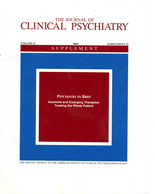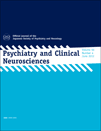
JOURNAL OF ECT
Scope & Guideline
Fostering Interdisciplinary Dialogue in Mental Health
Introduction
Aims and Scopes
- Electroconvulsive Therapy (ECT) Research:
The journal emphasizes rigorous research on ECT, exploring its efficacy, safety, and mechanisms of action in treating various psychiatric disorders. - Neurostimulation Techniques:
In addition to ECT, the journal covers emerging neurostimulation methods, such as transcranial magnetic stimulation (TMS) and theta-burst stimulation, contributing to the broader field of interventional psychiatry. - Clinical Practice Guidelines:
The journal aims to inform clinical practice by publishing studies that evaluate treatment protocols, safety standards, and patient outcomes associated with ECT and related therapies. - Education and Training:
There is a focus on educational initiatives, highlighting the importance of training healthcare professionals in ECT administration, patient care, and addressing stigma associated with the treatment. - Global Perspectives on ECT:
The journal explores the availability and practice of ECT across different countries, providing insights into cultural and systemic factors influencing its use.
Trending and Emerging
- Patient-Centric Approaches:
A growing emphasis on understanding patient experiences, preferences, and education regarding ECT is evident, indicating a shift towards more patient-centered care models. - Integration of Novel Technologies:
Research is increasingly exploring the integration of new technologies, such as virtual reality and digital health tools, to enhance ECT administration and patient monitoring. - Multimodal Treatment Strategies:
There is a trend towards investigating multimodal approaches that combine ECT with other treatments like TMS, ketamine, and psychotherapy, indicating a more holistic view of mental health treatment. - Focus on Special Populations:
Emerging themes include studies on the use of ECT in diverse populations, such as children, adolescents, and patients with comorbid conditions, highlighting the need for tailored treatment protocols. - Mental Health Impact of COVID-19:
The journal has increasingly addressed the implications of the COVID-19 pandemic on ECT practices, patient care, and mental health outcomes, reflecting the ongoing relevance of this global crisis.
Declining or Waning
- Historical Perspectives on ECT:
There has been a noticeable decrease in publications centered on historical analyses of ECT practices, indicating a shift towards contemporary research and clinical applications. - Basic Science Studies:
Research focused on the basic neurobiological mechanisms of ECT has diminished, possibly as more emphasis is placed on clinical outcomes and direct patient applications. - Single Case Reports:
The frequency of individual case reports has declined as the journal appears to prioritize larger studies and systematic reviews that provide broader insights into ECT's efficacy. - Comparative Studies with Traditional Psychopharmacology:
There is a waning interest in comparative studies between ECT and traditional psychopharmacological treatments, suggesting a shift towards exploring combination therapies and novel approaches.
Similar Journals

JOURNAL OF CLINICAL PSYCHIATRY
Fostering breakthroughs in the understanding of psychiatric disorders.The JOURNAL OF CLINICAL PSYCHIATRY is a premier publication dedicated to advancing the understanding and treatment of psychiatric disorders. Established in 1978 and published by Physicians Postgraduate Press, this esteemed journal provides a vital platform for researchers, clinicians, and mental health professionals to share innovative findings and evidence-based practices in psychiatry. With an impressive impact factor and recognized as a Q1 journal in both Medicine (miscellaneous) and Psychiatry and Mental Health, the journal ranks among the top in its field, sitting at 96th out of 567 in Scopus rankings, placing it in the 83rd percentile. The journal's commitment to high-quality, peer-reviewed articles facilitates the dissemination of knowledge crucial for advancing clinical practices and improving patient outcomes. Access to its latest research is offered through institutional subscriptions, making it an essential resource for anyone involved in the mental health sector, from seasoned practitioners to aspiring students.

Current Behavioral Neuroscience Reports
Bridging Neuroscience and Behavior for a Healthier TomorrowCurrent Behavioral Neuroscience Reports, published by SPRINGERNATURE, stands at the forefront of advancements in the intricate field of behavioral neuroscience. Since its inception in 2014, this journal has steadily garnered attention within academic circles, boasting a commendable ranking among its peers, including a Q3 classification in Behavioral Neuroscience and a Q2 classification in Public Health, Environmental and Occupational Health as of 2023. Although it operates under traditional access models, the journal is committed to disseminating high-quality research that bridges the gap between neuroscience and behavioral studies, appealing to researchers, professionals, and students alike. With a notable E-ISSN of 2196-2979, Current Behavioral Neuroscience Reports facilitates valuable insights that are critical for understanding the underlying mechanisms of behavior and their implications for public health and environmental factors. This journal is essential for those seeking to contribute to a multidisciplinary dialogue that enhances our comprehension of behavioral neuroscience.

Brain Stimulation
Transforming neuroscience through cutting-edge research.Brain Stimulation, published by Elsevier Science Inc, stands at the forefront of the interdisciplinary fields of biophysics, neurology, and neuroscience. With an impressive Q1 ranking in its categories and notable Scopus rankings—evidencing its influence in the realm of clinical neurology and general neuroscience—it serves as a critical platform for researchers seeking to disseminate innovative findings related to the applications and mechanisms of brain stimulation techniques. As an esteemed journal with a history of publication since 2008, Brain Stimulation is dedicated to enhancing our understanding of brain function through rigorous scientific inquiry and provides insights that are invaluable for both practitioners and academics alike. This journal exemplifies the importance of advancing research in therapeutic brain interventions, making it a vital resource for anyone involved in the neurological sciences.

DEPRESSION AND ANXIETY
Championing rigorous scholarship in mental health.DEPRESSION AND ANXIETY is a leading academic journal published by WILEY, dedicated to presenting cutting-edge research in the fields of clinical psychology, psychiatry, and mental health. With an impressive impact factor underscoring its prominence—ranked in the top quartile (Q1) for both clinical psychology and psychiatry, and occupying the 7th and 20th ranks in Scopus respectively—this journal serves as a pivotal resource for researchers, professionals, and students alike. Since its inception in 1996 and continuing through 2024, DEPRESSION AND ANXIETY has been at the forefront of disseminating findings that significantly impact our understanding of mental health issues. The journal's rigorous peer-review process ensures the highest quality of published works, making it an essential platform for scholars aiming to advance knowledge and contribute meaningfully to the mental health discourse.

EXPERIMENTAL BRAIN RESEARCH
Contributing to the Evolution of Neuroscientific KnowledgeEXPERIMENTAL BRAIN RESEARCH is a renowned journal published by SPRINGER, dedicated to advancing understanding in the field of neuroscience. With a history dating back to 1966, this journal offers valuable insights into the mechanisms of brain function and neurological disorders, making it a vital resource for researchers, professionals, and students alike. While it currently holds a Q3 classification in the field of Neuroscience (miscellaneous) and ranks #73 out of 113 in Scopus's General Neuroscience category, it continually contributes to fostering innovative research and collaborative dialogue. The journal is not open access, ensuring that although content is subscription-based, it maintains a high standard of peer review and scholarly rigor. By covering a breadth of topics relevant to both experimental and theoretical aspects of brain research, EXPERIMENTAL BRAIN RESEARCH serves as an essential platform for disseminating cutting-edge discoveries and theories in the dynamic realm of neuroscience.

PSYCHIATRY AND CLINICAL NEUROSCIENCES
Innovating Research for Better Mental Health OutcomesPSYCHIATRY AND CLINICAL NEUROSCIENCES is a leading journal in the fields of psychiatry and clinical neurology, published by Wiley. With a commendable impact factor and a position within the prestigious Q1 quartile across multiple relevant categories—including Medicine (Miscellaneous), Neurology, and Psychiatry and Mental Health—this journal stands out for its rigorous peer-reviewed content that addresses critical issues in mental health and neurological disorders. Established in 1933, the journal has a rich history of contributing impactful research that guides both clinical practice and academic inquiry. Although it is not an open-access journal, its high relevance is underscored by its Scopus rankings, with notable percentiles in Psychiatry and Neurology, making it a vital resource for researchers, clinicians, and students looking to stay abreast of the latest advancements. Located in the United Kingdom, PSYCHIATRY AND CLINICAL NEUROSCIENCES aims to bridge the gap between theory and practical application, fostering a comprehensive understanding of the complex interplay between mental health and neurological conditions.

Expert Review of Neurotherapeutics
Exploring New Horizons in NeurotherapyExpert Review of Neurotherapeutics is an esteemed journal published by Taylor & Francis Ltd, focusing on the rapidly evolving field of neurotherapeutics. With an ISSN of 1473-7175 and an E-ISSN of 1744-8360, this publication aims to bridge the gap between clinical and preclinical research, providing a platform for innovative therapeutic strategies in neurology and neuroscience. The journal boasts impressive impact factor rankings, categorized as Q2 in both clinical neurology and miscellaneous neuroscience, and Q1 in medical pharmacology for 2023. Its reputable placement in Scopus rankings, including Rank #82/400 in clinical neurology, underscores its significance within the medical research community. Spanning from 2001 to 2024, the journal publishes critical reviews and original research articles aimed at enhancing understanding and treatment in neurological disorders. Although it currently does not offer open access, articles published in the journal are crucial for researchers, healthcare professionals, and students seeking to stay at the forefront of advancements in neurotherapeutics. With its strong emphasis on rigorous peer-reviewed content, Expert Review of Neurotherapeutics continues to be a vital resource for those dedicated to improving patient outcomes in the realm of neurology.

PSYCHIATRIC CLINICS OF NORTH AMERICA
Bridging Research and Clinical Practice in PsychiatryPsychiatric Clinics of North America is a leading peer-reviewed journal published by W B Saunders Co-Elsevier Inc, dedicated to the dissemination of significant advances in the field of psychiatry and mental health. With an impressive track record spanning from 1978 to 2024, this journal is recognized for its contributions, achieving a Category Quartile ranking of Q2 in Psychiatry and Mental Health as of 2023. The journal aims to provide healthcare professionals, researchers, and students with comprehensive reviews, clinical insights, and the latest research findings, thereby enhancing the understanding and treatment of mental health disorders. As a crucial resource for practitioners and academicians alike, it ranks #282 out of 567 in the Scopus database, placing it within the 50th percentile of its field. While not an open-access journal, it offers a wealth of scholarly articles that are essential for anyone seeking to advance their knowledge in the complex and evolving landscape of psychiatric care.

PARKINSONISM & RELATED DISORDERS
Connecting research with real-world impact.PARKINSONISM & RELATED DISORDERS, published by Elsevier Science Ltd, is a prominent peer-reviewed journal dedicated to advancing the understanding of Parkinson's disease and related neurodegenerative disorders. With an impact factor placing it in the Q2 category across multiple fields including Geriatrics and Gerontology and Neurology for 2023, this journal serves as a crucial platform for researchers, healthcare professionals, and students alike. Covering an array of topics from clinical trials to innovative therapeutic strategies, it aims to disseminate valuable insights that can improve patient care and outcomes. While it remains a subscription-based journal, its relevance is underscored by its consistent rankings in Scopus, where it ranks 105th in Clinical Neurology and 35th in Geriatrics and Gerontology. Authored by top scholars in the field, PARKINSONISM & RELATED DISORDERS continues to contribute significantly to the body of knowledge surrounding these debilitating conditions, facilitating the exchange of cutting-edge research and fostering collaboration within the scientific community.

JOURNAL OF PSYCHIATRY & NEUROSCIENCE
Exploring the Intersection of Mind and BrainJOURNAL OF PSYCHIATRY & NEUROSCIENCE, published by the CMA-Canadian Medical Association, serves as a pivotal platform for disseminating cutting-edge research in the fields of psychiatry and neuroscience. This esteemed journal, indexed with the ISSN 1180-4882 and E-ISSN 1488-2434, focuses on advancing our understanding of mental health through meticulous peer-reviewed articles, reviews, and clinical studies. With an impressive impact within the research community, it has achieved notable rankings, including Q1 in both Medicine (miscellaneous) and Psychiatry and Mental Health, as well as Q2 in Biological Psychiatry as of 2023. The journal fosters critical dialogue among scholars and practitioners by offering insights into the complexities of brain function and mental disorders, making it a fundamental resource for healthcare professionals, researchers, and students alike. Although it operates under a subscription model, its rich content continues to inform and influence the advancement of mental health science, affirming its role in bridging the gap between research and clinical practice.